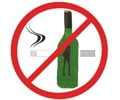Individuals with the inactive form of aldehyde dehydrogenase-2 (ALDH2) normally don't drink alcohol because it causes flushing, nausea, and headaches. A new study asks why some people with the inactive form of ALDH2 become alcohol dependent (AD). Results show these individuals have significantly higher novelty-seeking and lower harm-avoidance traits.
Personality factors can influence the development of alcohol dependence (AD). Researchers examined a group of AD individuals with the inactive form of aldehyde dehydrogenase-2 (ALDH2) – persons who would normally have a low incidence of alcoholism because the inactive form of ALDH2 causes flushing, nausea, and headaches. Results indicate that a strong need for novelty and little need for avoiding harm appear to increase the risk of AD.Findings will be published in the May issue of Alcoholism: Clinical & Experimental Research and are currently available at Early View.
"Some case-control studies have shown that high novelty-seeking (NS) and low harm-avoidance (HA) are associated with alcoholism," said Mitsuru Kimura, chief of the department of psychiatry and section of behavioral science at the National Hospital Organization. "But a personality profile associated with alcoholism is not well-established. This is the first study that demonstrates there is a difference between personality profiles of alcoholics with inactive and active form of ALDH2 polymorphism." Kimura is also the corresponding author for the study.
"Alcoholism is usually subtyped by clinical features, such as Type I vs. Type II or Type A vs. Type B," explained Ihn-Geun Choi, professor and chair of the department of neuropsychiatry at Hallym University College of Medicine in South Korea. "Researchers categorized alcoholics according to alcohol-metabolizing enzyme activities and studied their relevance to personality traits. This [study] is a new perspective of categorizing clinically similar alcoholics who were believed to have the same subtypes and personality profiles."
Researchers interviewed and genotyped 460 male Japanese alcoholics who had been hospitalized at the Kurihama Alcoholism Center. All patients filled out the Tridimensional Personality Questionnaire (TPQ). Of the total, 66 patients had the inactive form of ALDH2 (ALDH2*1/2*2), and 394 had the active form (ALDH2*1/2*1).
"Individuals who became alcoholics in spite of having a strong negative risk factor, the inactive type of ALDH2, revealed a characteristic personality profile, that is, higher NS and lower HA compared with those who had the active type of ALDH2," said Kimura. "This tells us that high NS and low HA are predisposing factors for alcoholism." High NS and low HA scores tend to reflect impulsive, danger-seeking, and aggressive personalities, he added.
Advertisement
"This study shows the alcoholics with inactive ALDH2 are a unique group with perhaps stronger risk factors for alcoholism," said Kimura. "Since the inactive ALDH2 group tended to have less familial alcoholic history, a study of alcoholics with inactive ALDH2 could be useful for detecting environmental or personality factors related to alcoholism."
Advertisement
LIN













